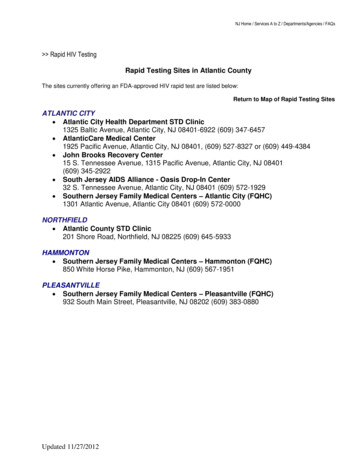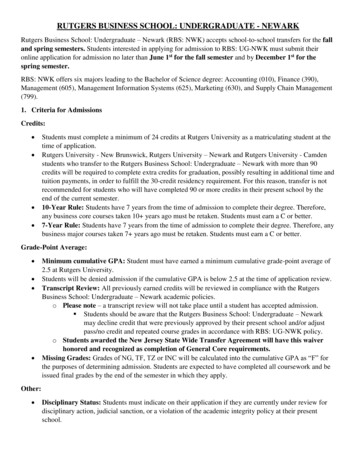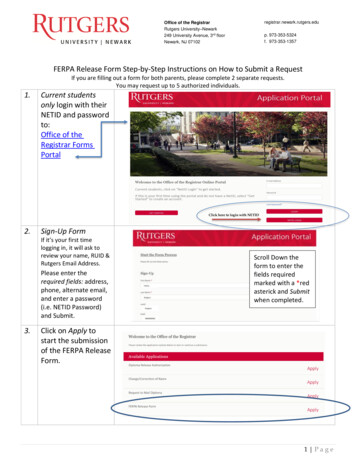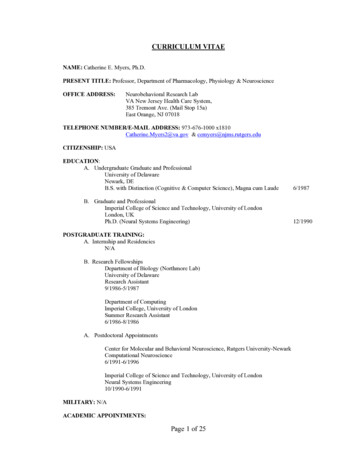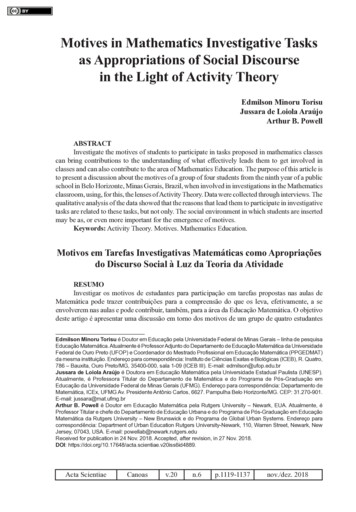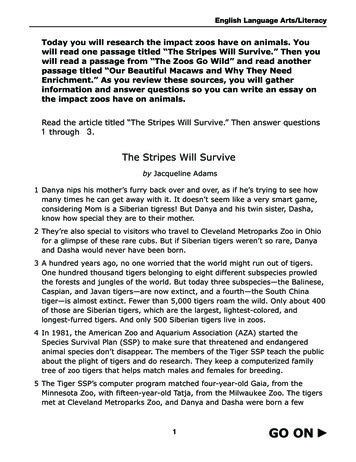
Transcription
English Language Arts/LiteracyToday you will research the impact zoos have on animals. Youwill read one passage titled “The Stripes Will Survive.” Then youwill read a passage from “The Zoos Go Wild” and read anotherpassage titled “Our Beautiful Macaws and Why They NeedEnrichment.” As you review these sources, you will gatherinformation and answer questions so you can write an essay onthe impact zoos have on animals.Read the article titled “The Stripes Will Survive.” Then answer questions18 through 10.3The Stripes Will Surviveby Jacqueline Adams1 Danya nips his mother’s furry back over and over, as if he’s trying to see howmany times he can get away with it. It doesn’t seem like a very smart game,considering Mom is a Siberian tigress! But Danya and his twin sister, Dasha,know how special they are to their mother.2 They’re also special to visitors who travel to Cleveland Metroparks Zoo in Ohiofor a glimpse of these rare cubs. But if Siberian tigers weren’t so rare, Danyaand Dasha would never have been born.3 A hundred years ago, no one worried that the world might run out of tigers.One hundred thousand tigers belonging to eight different subspecies prowledthe forests and jungles of the world. But today three subspecies—the Balinese,Caspian, and Javan tigers—are now extinct, and a fourth—the South Chinatiger—is almost extinct. Fewer than 5,000 tigers roam the wild. Only about 400of those are Siberian tigers, which are the largest, lightest-colored, andlongest-furred tigers. And only 500 Siberian tigers live in zoos.4 In 1981, the American Zoo and Aquarium Association (AZA) started theSpecies Survival Plan (SSP) to make sure that threatened and endangeredanimal species don’t disappear. The members of the Tiger SSP teach the publicabout the plight of tigers and do research. They keep a computerized familytree of zoo tigers that helps match males and females for breeding.5 The Tiger SSP’s computer program matched four-year-old Gaia, from theMinnesota Zoo, with fifteen-year-old Tatja, from the Milwaukee Zoo. The tigersmet at Cleveland Metroparks Zoo, and Danya and Dasha were born a few1
English Language Arts/Literacymonths later. When the twins entered the world on April 4, 2001, each was atwo-pound ball of woolly, striped fur.6 Tiger fathers in the wild don’t help care for their cubs and sometimes try to killthem. Tatja, whom zookeeper Steve Gove describes as “a mellow tiger,” getsalong well with Gaia and likes watching his cubs play. Although the zoo staffmembers keep Tatja in a separate area, they don’t think he would hurt thecubs.7 Gaia had never had cubs before, but Gove says, “She’s been an absolutelyperfect mother—tolerant, loving, and protective.” In the wild, tiger mothersteach their cubs to hunt. Danya and Dasha won’t need to hunt, but Gaiateaches them chasing and stalking techniques, as well as how to swim andgroom themselves.8 These lessons are pure fun for the twins. As soon as his sister’s back is turned,Danya crouches, then pounces, and the two roll across the grass in a wrestlingball of stripes and teeth. But she’ll get him back later, maybe when he’ssplashing in the pool during his swimming lesson or struggling to carry thepiece of log he’s turned into a toy. “They’ll make a toy out of anything,” saysGove.9 Grooming lessons come in handy for playful cubs who can’t resist rolling in themud. Gove explains, “Sometimes they’re so black you can hardly see theirstripes when they come in at night, but they’re completely clean by morning.”Mom has taught them to wash their fur with their tongues, and swallowing acouple pounds of mud doesn’t seem to bother them a bit.10 If mud doesn’t sound very tasty to you, how about raw horse meat? Tatjawould tell you (if he could) that nothing’s more delicious. On some nights helets supper sit for a while, but on horse-meat night he cares about nothing elseuntil he’s eaten every bite. Danya crouches jealously over his slab of meat. IfMom or Sis wanders too close, he lets out a deep growl that sounds as if itshould have come from his 500-pound father.11 With supper over, everyone in the tiger building is content. “Gaia and the cubsare pretty friendly,” says zoo-keeper Curt Gindlesperger. Proving him right,Gaia strolls to the fence and rubs against his hand like a 300-pound house cat.12 The tiger family seems comfortable in Cleveland, where the weather is similarto that of their natural habitat in eastern Russia. But the time may come tomove on. Tatja, who has cubs at two other zoos, will probably leave. The TigerSSP may also transfer one or both cubs to zoos where they will raise their own2
English Language Arts/Literacyfamilies. Then Danya and Dasha will help make sure Siberian tigers are aroundfor a long, long time.13 But what about the 400 Siberian tigers left in their natural habitat? How willthey survive?14 The World Wildlife Fund (WWF) and other organizations are working with theRussian government to set aside protected areas for these big cats. Rangerspatrol for poachers, and educational programs help the local people understandthe need to protect Siberian tigers. These efforts seem to be working. TheWWF believes that the number of Siberian tigers in the wild has doubled sincethe antipoaching patrols began, bringing the tiger numbers from around 200 in1994 to about 400 today.Reprinted by permission of SPIDER magazine, April 2004, copyright 2004 byCarus Publishing Company.3
English Language Arts/Literacy8.1. Part AWhat does the word plight mean as it is used in paragraph 4 of “The StripesWill Survive”?Adesperate situationBhiding placeCmovementDrecoveryPart BWhich sentence from the article supports the answer to Part A?A“One hundred thousand tigers belonging to eight different subspeciesprowled the forests and jungles of the world.”B“Fewer than 5,000 tigers roam the wild.”C“The tigers met at Cleveland Metroparks Zoo, and Danya and Dasha wereborn a few months later.”D“Although the zoo staff members keep Tatja in a separate area, they don’tthink he would hurt the cubs.”4
English Language Arts/Literacy9.2.Part AThe author makes the claim that steps have been taken to help endangeredtigers. Select the main strategy used throughout the article to develop theclaim.AThe author explains a problem and then presents solutions.BThe author details the cause and effect of an event or action.CThe author shares important events or actions in their order ofimportance.DThe author presents a detailed list of problems.Part BSelect three pieces of evidence that support the answer to Part A.A“They’re also special to visitors who travel to Cleveland Metroparks Zoo inOhio for a glimpse of these rare cubs.”B“But today three subspecies—the Balinese, Caspian, and Javan tigers—are now extinct, and a fourth—the South China tiger—is almost extinct.”C“They keep a computerized family tree of zoo tigers that helps matchmales and females for breeding.”D“Tatja, whom zookeeper Steve Gove describes as ‘a mellow tiger,’ getsalong well with Gaia and likes watching his cubs play.”E“Grooming lessons come in handy for playful cubs who can’t resist rollingin the mud.”F“One hundred thousand tigers belonging to eight different subspeciesprowled the forests and jungles of the world.”G“The World Wildlife Fund (WWF) and other organizations are working withthe Russian government to set aside protected areas for these big cats.”5
English Language Arts/Literacy3 Part A10.What is the author’s main purpose in “The Stripes Will Survive”?Ato describe the different lessons Gaia teaches her cubsBto explain recent changes in how zoos raise Siberian tigersCto explain the efforts being made to preserve Siberian tigersDto describe how Danya and Dasha interact with their parentsPart BWhich sentence from the article supports the answer to Part A?A“It doesn’t seem like a very smart game, considering Mom is a Siberiantigress!”B“Only about 400 of those are Siberian tigers, which are the largest,lightest-colored, and longest-furred tigers.”C“And only 500 Siberian tigers live in zoos.”D“Rangers patrol for poachers, and educational programs help the localpeople understand the need to protect Siberian tigers.”6
English Language Arts/LiteracyRead the passage titled “The Zoos Go Wild,” from the book No MoreDodos. Then answer questions 11 and 12.The Zoos Go Wild from No More Dodosby Nicholas Nirgiotis and Theodore Nirgiotis1 The small lowland gorilla was just three years old when he was caught bypoachers, people who illegally kill or capture wild animals. He was taken awayfrom his mother and out of his African rainforest home. Few gorillas that agecould survive such an ordeal, but this one was lucky. Soon after his capture in1961, an animal trader sold him to Zoo Atlanta. He spent the next 27 years ofhis life alone in an indoor cage. Zoo personnel named him Willie B. afterWilliam B. Hartsfield, the mayor of Atlanta.2 Willie’s keepers wanted him to be happy. They hung an old tire from a wall ofhis cage and put a television set in one corner. They hoped these toys wouldkeep Willie from being bored. But the tire and the television set were hardlythe playthings a growing gorilla needed.3 By age 12, Willie had grown into a magnificent 460-pound,6-foot-tallsilverback, a mature male with a distinguishing streak of silver hair on hisback. His broad chest and powerful arms made people think of King Kong. Theycrowded in front of his cage to see him.4 Gorillas are gentle, shy creatures, despite their size and fearsome appearance.But confinement in a cramped cage and lack of exercise had made Willierestless and bad-tempered. He grew fat and lazy, paced in his cage, andignored visitors. His cage was a real prison, and Willie B. was a very unhappygorilla.5 A turning point in Willie’s life came in 1988. That year Zoo Atlanta opened theFord African Rainforest, a brand-new home for Willie and the zoo’s otherlowland gorillas. It was a large open-air enclosure designed to resemble therainforest of Willie’s native central Africa.The Way Willie Likes It6 Willie’s rainforest home is just one example of the far-reaching changes thathave taken place in zoos in recent years. Zoos no longer feel their primarymission is simply to collect and display as many different species of animalsfrom around the world as they possibly can. They no longer believe that themore unusual animals a zoo has, the better it is. Instead, zoos are changing7
English Language Arts/Literacyinto conservation parks that cooperate to help save animals threatened withextinction. The first step toward this goal was to get rid of the cages andchange the way zoo animals lived.7 When Willie was let out of his cage into his new home, he found himself in alarge grassy area leading to a gradually rising, rock-covered slope. All aroundthe edges of the slope were trees and plants similar to those in his Africanhome.8 In no time, Willie acted like a different animal. He was no longer bored oreasily angered. There were tree branches he could pull to test his strength orbend into a nest for his afternoon siesta,1 and there was a rocky hillside hecould climb. More important, he had company. He shared his new home withthree females, and other groups of gorillas lived nearby. Willie could finally actlike the silverback he was. He could have his own family and be the dominantmale.9 Willie had not lost the instinct for peaceful family life that gorillas live by in thewild. He watched over his family when it was feeding or resting, ever alert fordanger. His companions could chase each other and wrestle, knowing he wasthere to protect them. Every so often, he would cup his hands and thump hischest to show the females and nearby rival males who was boss. Willie B. hadfinally become a real gorilla. In February 1994, he became a father as well.10 Three other gorilla groups share Zoo Atlanta’s African Rainforest enclosure withWillie’s family. They are kept apart from each other by trees and small hills thatmark their territories, just the way it would be in Africa. The gorillas spendtheir time looking for bamboo shoots and leaves to eat, grooming each other,napping between meals, or just resting.11 Willie’s story has a happy ending. But the best part is that he is not alone in hisgood fortune. Thousands of other zoo animals throughout the world have beenmoved into new homes that replaced the old, cramped cages in which theylived before.Lessons from Germany12 Housing animals in open-air, natural enclosures is not a new idea. The first touse such a setting was Karl Hagenbeck at the Hamburg Zoo, Germany, in 1907.He moved antelopes into a grassy, open area. To add a touch of drama, heplaced a pride of lions just behind them. Visitors to the zoo were startled to1siesta—nap8
English Language Arts/Literacyfind lions living next to antelopes. They could not see the moat that separatedthe predators from their prey.13 Hagenbeck’s novel idea of allowing animals to move about freely in large openspaces caught on. He was asked to redesign the Detroit Zoo in the 1930s. Hisideas were also used in New York’s Bronx Zoo, Chicago’s Brookfield Zoo, andthe San Diego Zoo.14 But large-scale redesigning of zoos didn’t begin until the 1960s, when naturalhabitats of wild animals around the world began to shrink in size, and scores ofspecies dwindled to the point of vanishing. Zoo designers traveled to theanimals’ natural habitats in faraway places to study not only what the habitatslooked like but how the animals used the space and behaved in it. Housinganimals in spaces that were as close to the animals’ habitats as the designerscould make them was an important step in the struggle to save endangeredspecies.Excerpt from NO MORE DODOS: HOW ZOOS HELP ENDANGERED WILDLIFE byNicholas Nirgiotis and Theodore Nirgiotis, copyright 1996 by NicholasNirgiotis and Theodore Nirgiotis. Used by permission of the authors.927
English Language Arts/Literacy4 Part A11.Read the sentence from paragraph 14 of the passage “The Zoos Go Wild.”Housing animals in spaces that were as close to the animals’ habitats asthe designers could make them was an important step in the struggle tosave endangered species.What does the word endangered mean as it is used in the Part BWhich detail from paragraph 14 of the passage supports the answer toPart A?A“. . . large-scale redesigning of zoos didn’t begin until the 1960s . . . .”B“. . . dwindled to the point of vanishing.”C“Zoo designers traveled to the animals’ natural habitats in farawayplaces . . . .”D“. . . how the animals used the space and behaved in it.”1028
English Language Arts/Literacy5 Part A12.Which detail from the passage “The Zoos Go Wild” supports the idea thatWillie changed after being moved into his new home?Athe comparison of the grassy area to Willie’s African homeBthe mention of Willie’s large size and magnificent appearanceCthe description of Willie’s behavior with his companionsDthe comparison of Willie to gorillas that live in the wildPart BWhich paragraph from the passage best supports the answer to Part A?Aparagraph 7Bparagraph 9Cparagraph 10Dparagraph 111129
English Language Arts/LiteracyRefer to the article titled “The Stripes Will Survive” and passage titled “TheZoos Go Wild.” Then answer question 13.6 Part A13.Choose a central idea that is developed in both “The Stripes Will Survive” and“The Zoos Go Wild.”AZoos are constantly changing exhibits to keep visitors interested in theanimals.BZoos are sometimes responsible for caring for animals that people haveabandoned.COne responsibility of a zoo is to prevent the extinction of species bybreeding them.DZoos are changing their approaches to caring for their animals.Part BChoose one detail from each passage that supports the answer to Part A.A“But Danya and his twin sister, Dasha, know how special they are to theirmother.” (“The Stripes Will Survive”)B“In 1981, the American Zoo and Aquarium Association (AZA) started theSpecies Survival Plan (SSP) to make sure that threatened andendangered animal species don’t disappear.” (“The Stripes Will Survive”)C“Gaia had never had cubs before, but Gove says, ‘She’s been anabsolutely perfect mother—tolerant, loving and protective.’” (“The StripesWill Survive”)D“They hung an old tire from a wall of his cage and put a television set inone corner.” (“The Zoos Go Wild”)E“His companions could chase each other and wrestle, knowing he wasthere to protect them.” (passage from “The Zoos Go Wild”)F“Thousands of other zoo animals throughout the world have been movedinto new homes that replaced the old, cramped cages in which they livedbefore.” (passage from “The Zoos Go Wild”)3012
English Language Arts/LiteracyRead the passage from the article “Our Beautiful Macaws and Why TheyNeed Enrichment.” Then answer question 14.from “Our Beautiful Macaws and Why They NeedEnrichment” Alicia Powers, Oakland Zooby Alicia Powers1 Oakland Zoo’s Animal Care, Conservation, and Research team has the privilegeand challenge of providing our animal residents with an enriching,well-balanced life and advocating for the conservation of their wildcounterparts.2 The zoo’s flock of Blue and Gold Macaws recently got a healthy dose of extraenrichment. The ACCR1 team combed through a handful of creative ideas togive the Macaw Exhibit a new, fresh look. In addition to replacing some of thewood perching that had suffered significant wear-and-tear from years of theMacaws using them to keep their beaks sharp and strong, the team also addedtwo twenty foot sections of rope. The rope is a novel perching surface in this1ACCR—Animal Care, Conservation, and Research3113
English Language Arts/Literacy Alicia Powers, Oakland Zooexhibit. It will not only give our Blue and Gold Macaws something new and funto play with, but it will also help keep their little feet healthy. With someresourceful alterations to the ends of the rope, the keepers are able to movethe ropes to different angles whenever they please. This way the birds get a bitof a “different look” with their perching without the keepers having to makeany permanent rearrangements.3 The fun doesn’t stop there though! The team recycled some cargo netting andstretched it out between some perching to support brand new bird baths. Justlike the native songbirds that like to bathe in the little puddles in your yard,Macaws and other Parrots love to keep themselves clean too.4 But one may wonder . . . why? Why do our Blue and Gold Macaws deserve thisspecial treatment?5 Macaws are smart. Macaws are REALLY smart and curious. It is this verycharacteristic that makes them coveted as pets. Ironically, it is also whatmakes them inappropriate as a pet. Meeting the behavioral and enrichmentneeds of these incredibly smart birds is difficult. A behaviorally unhealthy birdmay become aggressive, destructive, or even sick.1432
Alicia Powers, Oakland ZooEnglish Language Arts/Literacy6 Add to this the fact that Blue and Gold Macaws can live for over 60 years, andthe bird often becomes an unbearable burden even for well-intentionedowners. In fact, the four Blue and Gold Macaws in the zoo’s collection camefrom such circumstances. The keepers responsible for the daily care of ourMacaws are tasked with keeping them behaviorally and medically sound.Having flexible and varied perching options will help immensely with this goal. Alicia Powers, Oakland Zoo1533
English Language Arts/Literacy7 Part A14.What is the meaning of novel as it is used in paragraph 2?AlengthyBuniqueCsolidDtexturedPart BWhich phrase from paragraph 2 supports the answer to Part A?A“wear-and-tear”B“twenty foot sections”C“new and fun”D“little feet healthy”16
English Language Arts/LiteracyRefer to the article titled “The Stripes Will Survive” and passage from thearticle “Our Beautiful Macaws and Why They Need Enrichment.” Thenanswer question 15.15.8 Part AWhich sentence describes how central ideas are introduced in “The StripesWill Survive” and “Our Beautiful Macaws and Why They Need Enrichment”?A“The Stripes Will Survive” provides details about a particular zoo habitat,while “Our Beautiful Macaws and Why They Need Enrichment” describesthe daily duties of zookeepers.B“The Stripes Will Survive” explains one animal’s background, while “OurBeautiful Macaws and Why They Need Enrichment” details the researchcarried out at one zoo.C“The Stripes Will Survive” tells an anecdote about a particular animalfamily, while “Our Beautiful Macaws and Why They Need Enrichment”describes the zookeepers’ role in updating the habitat for the birds.D“The Stripes Will Survive” explains the importance of the American Zooand Aquarium Association in protecting animals in zoos, while “OurBeautiful Macaws and Why They Need Enrichment” describes the beautifulcolors of the birds in a particular zoo.Part BSelect one detail from each text that supports the answer to Part A.A“Danya nips his mother’s furry back over and over . . . .” (paragraph 1,“The Stripes Will Survive”)B“They’re also special to visitors who travel to Cleveland MetroparksZoo . . . .” (paragraph 2, “The Stripes Will Survive”)C“A hundred years ago, no one worried that the world might run out oftigers.” (paragraph 3, “The Stripes Will Survive”)D“The zoo’s flock of Blue and Gold Macaws recently got a healthy dose ofextra enrichment.” (paragraph 2, “Our Beautiful Macaws and Why TheyNeed Enrichment”)E“With some resourceful alterations to the ends of the rope, the keepersare able to move the ropes to different angles . . . .”(paragraph 2, “Our Beautiful Macaws and Why They Need Enrichment”)F“The keepers responsible for the daily care of our Macaws . . . .”(paragraph 6, “Our Beautiful Macaws and Why They Need Enrichment”)17
English Language Arts/LiteracyRefer to the passage from the article “Our Beautiful Macaws and Why TheyNeed Enrichment.” Then answer question 16.9 Part A16.What is the author’s main purpose in “Our Beautiful Macaws and Why TheyNeed Enrichment”?Ato describe the different tasks zookeepers are required to performBto explain why some pet Macaws eventually live in zoosCto explain how a zoo is providing a stimulating environment for MacawsDto describe why zookeepers include specific equipment in new exhibitsPart BWhich sentence from the article best supports the answer to Part A?A“The ACCR team combed through a handful of creative ideas to give theMacaw Exhibit a new, fresh look.”B“This way the birds get a bit of a ‘different look’ with their perchingwithout the keepers having to make any permanent rearrangements.”C“A behaviorally unhealthy bird may become aggressive, destructive, oreven sick.”D“Add to this the fact that Blue and Gold Macaws can live for over 60years, and the bird often becomes an unbearable burden even for wellintentioned owners.”1836
English Language Arts/LiteracyRefer to the article titled “The Stripes Will Survive,” the passage titled “TheZoos Go Wild,” and passage from the article “Our Beautiful Macaws andWhy They Need Enrichment.” Then answer question 17.10 You have read three texts that claim that the role of zoos is to protect17.animals. Write an essay that compares and contrasts the evidence eachsource uses to support this claim. Be sure to use evidence from all threesources to support your response.19
English Language Arts/Literacy17.10 Continued20
English Language Arts/Literacy10 Continued17.21
English Language Arts/Literacy17.10 Continued4022
A turning point in Willie s life came in 1988. That year Zoo Atlanta opened the Ford African Rainforest, a brand-new home for Willie and the zoo s other lowland gorillas. It was a large open-air enclosure designed to resemble the rainforest of Willie s native central Africa. The Way Willie Likes It



